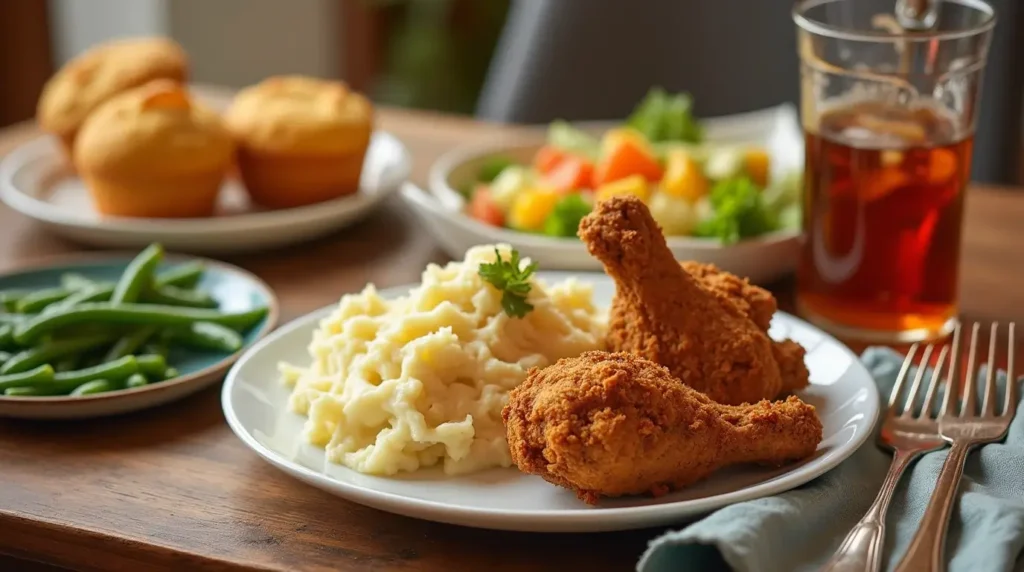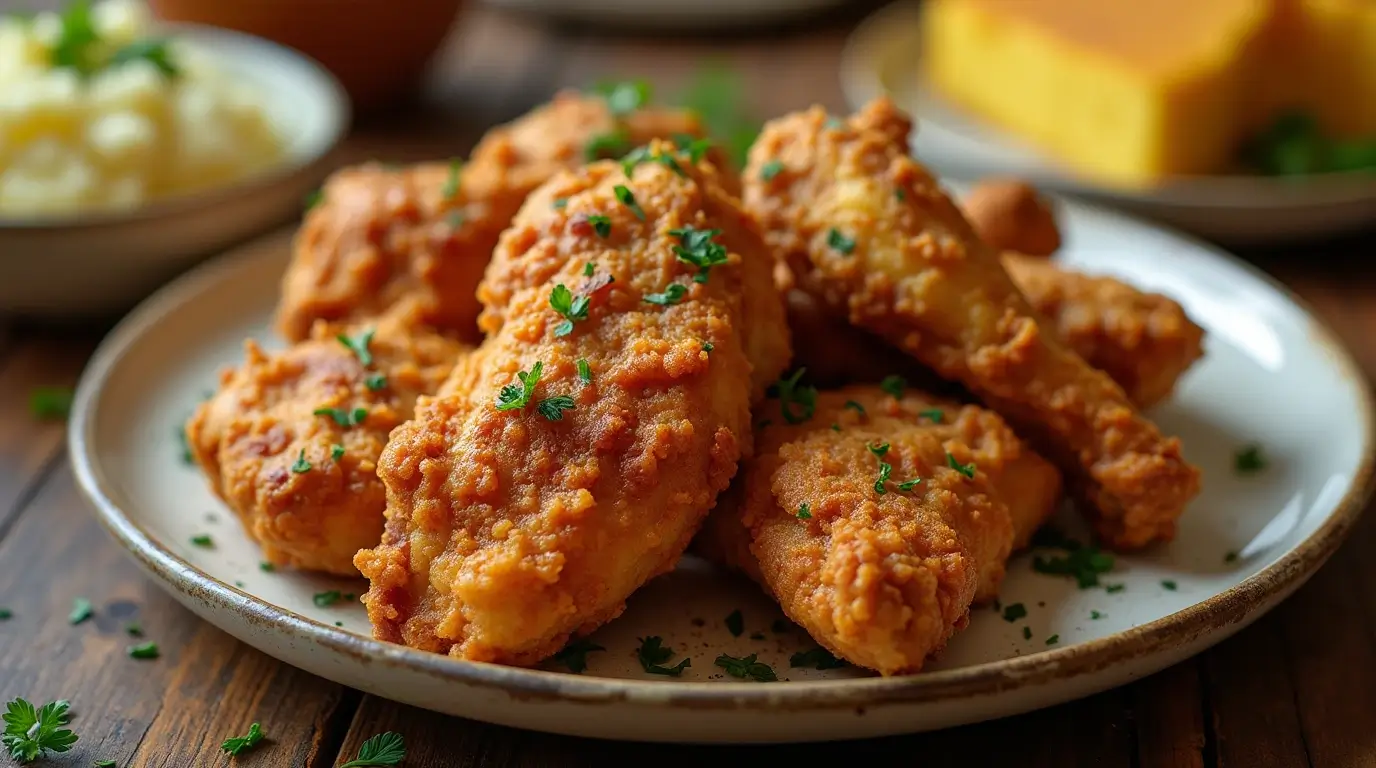If you’ve ever skipped making fried chicken just because you didn’t have buttermilk, I’m here to tell you—you don’t need it! This fried chicken recipe without buttermilk proves that you don’t need a special ingredient to get that perfect crunch and juicy, flavorful meat.
Some of the best fried chicken I’ve ever made came from working with what I had on hand. Whether you’re out of buttermilk, avoiding dairy, or just looking for a simpler way to fry up a batch of homemade goodness, this recipe has you covered. So don’t wait—grab your ingredients, heat up that oil, and get ready for some seriously delicious fried chicken, no buttermilk required!
Table of Contents
The Allure of Fried Chicken
Fried chicken holds a special place in the hearts—and stomachs—of food lovers around the globe. It’s that perfect combination of crispy crust and tender, juicy meat that makes it a go-to comfort food. But here’s the kicker: most recipes call for buttermilk, which can be a dealbreaker for those avoiding dairy. Thankfully, you don’t need buttermilk to achieve that golden crunch.
Why Skip the Buttermilk?
The traditional use of buttermilk in fried chicken recipes stems from its role as a tenderizer, thanks to its acidic nature. But who has time to marinate for hours? By swapping out buttermilk, you can simplify the process while still creating mouthwatering fried chicken. Not to mention, it’s an excellent option for those looking for dairy-free or kosher-friendly recipes.
This article will show you how to make a fried chicken recipe without buttermilk that’s just as flavorful and crispy. Stay tuned as we delve into its history, step-by-step preparation, and all the tricks to making fried chicken that’s finger-lickin’ good!
A Brief History of Fried Chicken
Origins in Southern Cuisine
Fried chicken has a rich history, deeply rooted in the traditions of Southern cooking. It was introduced to the American South by Scottish immigrants, who brought their love for pan-frying chicken. Unlike the English, who often boiled or baked their chicken, the Scots preferred frying, which resulted in the crispy and flavorful texture we know today. This technique later evolved into the fried chicken recipes that became a staple in Southern homes.
Cultural Influences: Scots-Irish and West African Traditions
West African cooks significantly enhanced fried chicken by introducing seasoning and spices, creating the flavorful dishes we now associate with soul food. These cultural exchanges turned a simple method of frying chicken into a celebrated culinary tradition. Over time, fried chicken became a symbol of comfort and hospitality in Southern cuisine, cherished by families and friends alike.
Ingredients for Perfect Fried Chicken Without Buttermilk
Essential Ingredients List
Creating the perfect fried chicken recipe without buttermilk starts with selecting the right ingredients. Here’s what you’ll need:
- Chicken pieces (thighs, drumsticks, or a whole chicken, cut into parts)
- All-purpose flour
- Eggs (to replace the buttermilk)
- Spices and seasonings (e.g., paprika, garlic powder, salt, pepper)
- High-heat oil (like vegetable or peanut oil)
Using eggs instead of buttermilk keeps the recipe dairy-free while maintaining a rich coating that crisps up beautifully during frying.
Substitutions and Their Impact on Flavor and Texture
Want to experiment? Replace all-purpose flour with gluten-free alternatives, such as cornstarch or rice flour, to create a crispier texture. Or, for an extra flavor boost, add herbs like thyme or rosemary to your seasoning mix. These tweaks allow you to tailor the recipe to your dietary needs or personal preferences.
For those interested in alternative chicken recipes, check out grilled chicken thigh recipes for a healthier yet equally delicious option.
Step-by-Step Instructions for Fried Chicken without Buttermilk
Preparing the Chicken: Cutting and Brining
To start your fried chicken recipe without buttermilk, choose fresh, bone-in chicken pieces like thighs, drumsticks, or breasts. Pat them dry with a paper towel to remove excess moisture. While buttermilk isn’t needed, you can enhance the flavor by dry brining the chicken with a generous amount of kosher salt. Let it sit in the fridge for at least 30 minutes or up to 24 hours.
Double Dredging Technique Explained
Double dredging is the secret to achieving a crispy, golden crust. Here’s how it works:
- First, whisk together eggs in one bowl and mix flour with seasonings in another.
- Coat each piece of chicken in the flour mixture, ensuring an even layer.
- Dip the floured chicken into the egg wash, then back into the flour mixture. This double coating ensures a thick, crunchy crust.
Temperature Control for Crispy Chicken
Oil temperature is crucial for perfect frying. Heat about an inch of oil in a deep skillet to 350°F (175°C). If the oil is too hot, the crust will burn before the chicken cooks; too cool, and the chicken will absorb excess oil. Fry each piece for 10-15 minutes, flipping halfway, until the internal temperature reaches 165°F (74°C).
Alternative Cooking Methods: Air Fryer and Oven
If you’re looking for a healthier option, air frying is an excellent alternative. Preheat the air fryer to 375°F, coat the chicken lightly with oil spray, and cook for 20-25 minutes. Baking is another choice—place the chicken on a wire rack, bake at 400°F for 30-35 minutes, and flip halfway for even crispiness.
For more mouthwatering chicken dishes, consider exploring delicious and healthy chicken cabbage recipes.
PrintThe Ultimate Guide to Fried Chicken Without Buttermilk
- Total Time: 45 minutes
- Yield: 4 servings 1x
Description
This simple fried chicken recipe without buttermilk ensures everyone can enjoy a plate of crispy, delicious chicken with pantry-friendly ingredients.
Ingredients
For the Chicken:
- 2 lbs (900 g) chicken pieces (drumsticks, thighs, wings, or a mix)
- 1 1/2 teaspoons salt
- 1 teaspoon garlic powder
- 1 teaspoon onion powder
- 1 teaspoon smoked paprika (optional)
- 1/2 teaspoon black pepper
For the Coating:
- 2 cups all-purpose flour
- 1/4 cup cornstarch
- 1 teaspoon baking powder
- 1 teaspoon salt
- 1 teaspoon garlic powder
- 1 teaspoon onion powder
- 1/2 teaspoon smoked paprika
- 1/4 teaspoon cayenne pepper (optional, for heat)
- 1/2 teaspoon black pepper
For the Egg Wash:
- 2 large eggs
- 1/4 cup milk (or water if dairy-free)
For Frying:
- Vegetable oil, for deep frying (enough to fill a pot about 2–3 inches deep)
Instructions
Prepare the Chicken:
- Pat chicken pieces dry with a paper towel to remove excess moisture. This helps the coating stick better.
- In a large bowl, combine salt, garlic powder, onion powder, smoked paprika, and black pepper. Rub the seasoning evenly over the chicken pieces. Let sit for 15 minutes to allow the flavors to penetrate.
Make the Coating:
- In a medium bowl, whisk together the flour, cornstarch, baking powder, salt, garlic powder, onion powder, smoked paprika, cayenne pepper, and black pepper.
Prepare the Egg Wash:
- In another bowl, whisk together eggs and milk (or water).
Coat the Chicken:
- Dredge each piece of chicken in the flour mixture, shaking off any excess.
- Dip the chicken into the egg wash, then back into the flour mixture, pressing gently to create a thick, even coating. Set coated chicken aside on a wire rack for 5–10 minutes. This resting time helps the coating adhere.
Fry the Chicken:
- Heat oil in a deep, heavy-bottomed pot or deep fryer to 350°F (175°C). Use a thermometer to maintain consistent oil temperature.
- Carefully add chicken pieces to the hot oil, being careful not to overcrowd the pot (fry in batches if necessary). Fry for 12–15 minutes, turning occasionally, until the chicken is golden brown and cooked through. The internal temperature should reach 165°F (74°C).
- Transfer cooked chicken to a wire rack or paper towel-lined plate to drain excess oil.
Serve:
- Enjoy hot with your favorite sides, such as mashed potatoes, coleslaw, or cornbread.
Notes
- Cornstarch: This ingredient is key for an extra crispy coating.
- Baking Powder: Helps create a light, airy crust.
- Oil Temperature: Maintaining 350°F (175°C) ensures even cooking and prevents the chicken from becoming greasy.
- Storage: Leftover fried chicken can be reheated in the oven at 375°F (190°C) for 10–15 minutes to regain crispiness.
- Prep Time: 20 min
- Cook Time: 25 min
Nutrition
- Serving Size: 1/2 pound of chicken with breading
- Calories: 470
- Sugar: 1g
- Sodium: 920mg
- Fat: 24g
- Saturated Fat: 5g
- Unsaturated Fat: 16g
- Trans Fat: 0
- Carbohydrates: 30g
- Fiber: 2g
- Protein: 31g
- Cholesterol: 155mg
Seasoning Variations and Enhancements
Classic Southern Style Seasoning
A traditional Southern fried chicken recipe is known for its simple yet flavorful seasoning. Combine salt, pepper, paprika, and garlic powder to create a balanced taste that highlights the crispy crust and juicy chicken. For a deeper flavor, try adding a pinch of white pepper or cayenne.
Spicy and Bold Flavors: Adding a Twist
For those who like a kick, experiment with bold spices like chili powder, smoked paprika, or Cajun seasoning. You can even infuse heat into the batter by mixing hot sauce into the egg wash.
Gluten-Free and Kosher Options
If you’re avoiding gluten, substitute all-purpose flour with cornstarch or rice flour. These alternatives not only meet dietary restrictions but also make the chicken extra crispy. For a kosher-friendly option, ensure the chicken and oil meet kosher standards, and use egg-based dredging instead of dairy.
If you’re interested in other protein-packed recipes, check out this Chicken and Cream of Mushroom Recipe
Troubleshooting Common Issues
Why Is My Chicken Not Crispy?
One of the most common pitfalls in making a fried chicken recipe without buttermilk is ending up with soggy chicken. This often happens if the oil temperature is too low. The chicken absorbs excess oil instead of frying to a crisp. To avoid this, always use a thermometer to maintain an oil temperature between 350°F and 375°F. Additionally, overcrowding the pan can cause the oil to cool quickly, so fry in small batches.
Dealing with Undercooked Chicken
Nobody likes biting into undercooked chicken. If your chicken is golden on the outside but raw inside, the oil may be too hot, cooking the crust too quickly. To fix this, lower the heat slightly and allow the chicken to cook longer. For extra assurance, use a meat thermometer to confirm that the internal temperature reaches 165°F.
Avoiding Greasy Results
Greasy chicken is a sign that the batter hasn’t adhered properly or the oil isn’t hot enough. To prevent this, pat the chicken dry before dredging and ensure the oil sizzles when a small drop of batter is added. After frying, let the chicken rest on a wire rack instead of paper towels to keep it crispy.
Pairings for Fried Chicken without Buttermilk
Traditional Sides: Mashed Potatoes, Cornbread, and Greens

No fried chicken without buttermilk is complete without a lineup of comforting sides. Classic mashed potatoes with creamy gravy make a perfect pairing, while fluffy cornbread adds a touch of sweetness. For a traditional Southern twist, serve your fried chicken with collard greens or black-eyed peas.
Unique Pairings: Slaws and Spicy Sauces
For a lighter contrast, a tangy coleslaw can cut through the richness of fried chicken. You can also spice things up by adding hot honey, buffalo sauce, or a zesty garlic aioli as a dip. These bold flavors elevate the dish, making it a hit at gatherings.
For more delicious meal ideas, explore recipes like grilled chicken thigh recipes to complement your table with variety.
Frequently Asked Questions on Fried Chicken without Buttermilk
Can I Make Fried Chicken Ahead of Time?
Yes, you can! Preparing your fried chicken recipe without buttermilk in advance is a great way to save time. Once cooked, store the fried chicken in an airtight container in the refrigerator for up to four days. Reheat it in an oven or air fryer at 375°F until it’s hot and crispy. Avoid microwaving, as it can make the crust soggy.
What Are Good Dairy-Free Substitutes for Buttermilk?
If you’re looking to replace buttermilk in a recipe, there are several simple options. Eggs work beautifully in this fried chicken recipe without buttermilk, ensuring the crust sticks while keeping the chicken juicy. Alternatively, plant-based milk mixed with a teaspoon of vinegar can mimic buttermilk’s tanginess for marinating.
How Do I Reheat Fried Chicken?
To maintain the crispiness of leftover fried chicken, reheat it in an oven at 350°F for about 10-15 minutes or use an air fryer for faster results. Avoid reheating on a stovetop, as it can make the chicken greasy.
What Are the Best Oils for Fried Chicken without Buttermilk?
Oils with a high smoke point, such as peanut, canola, or vegetable oil, are ideal for frying chicken. These oils ensure the chicken cooks evenly and achieves a crispy texture without burning.
Expert Tips for Perfect Fried Chicken Without Buttermilk
The Importance of Oil Temperature
Keeping the oil at the right temperature is critical for a successful fried chicken recipe without buttermilk. Too hot, and the crust will burn before the chicken cooks through; too cool, and you’ll end up with oily chicken. Use a kitchen thermometer to keep the oil between 350°F and 375°F.
How to Store and Freeze Fried Chicken
If you have leftovers, store them in an airtight container and refrigerate for up to four days. To freeze, wrap the cooled chicken in plastic wrap or foil, place it in a freezer bag, and freeze for up to three months. Thaw frozen chicken in the fridge overnight before reheating.
Maximizing Flavor with Dry Brining
Dry brining is a simple technique that elevates the flavor and texture of your chicken. Sprinkle kosher salt over the chicken pieces and let them sit in the refrigerator for several hours before cooking. This process locks in moisture and creates a crispy crust during frying.
Serve your Fried Chicken without Buttermilk with a side of these delicious Crispy Smashed Parmesan Potatoes
Final Thoughts on Fried Chicken without Buttermilk
Fried chicken without buttermilk? Absolutely! If there’s one thing I’ve learned in my years of cooking, it’s that great food is all about flexibility. Whether you’re out of buttermilk or just looking for an alternative, this recipe proves you don’t need it to achieve crispy, juicy, and downright irresistible fried chicken. With the right seasoning, a well-balanced dredging method, and a few simple tricks, you can still get that perfect golden crunch every time. So don’t let a missing ingredient hold you back—get in the kitchen, fry up a batch, and enjoy every crispy, flavorful bite. And if you discover your own twist along the way, even better! Cooking is all about making it your own.

